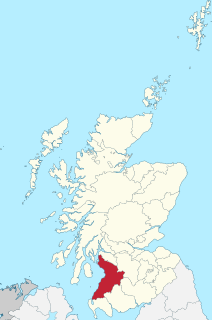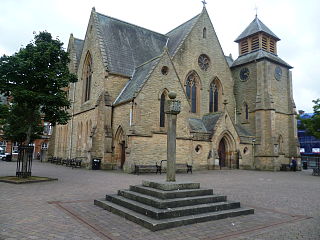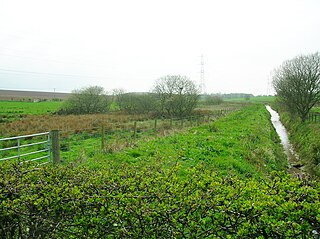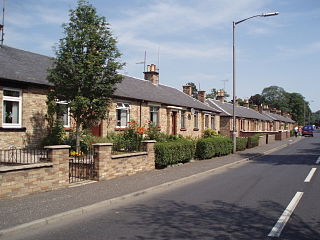
Cronberry is a small hamlet situated north-east of Cumnock and one mile north-east of Lugar, in East Ayrshire, Scotland.

Cronberry is a small hamlet situated north-east of Cumnock and one mile north-east of Lugar, in East Ayrshire, Scotland.

| Etymology |
| The meaning of Cronberry is suggested by Johnston [1] as being from the Gaelic cronag, a 'a fort' and the Old English byrig, a 'burgh' or 'fortified place'. |
Cronberry has a Women's Rural Institute which meets in the old school. [2]
Diane and Holly Fallon were murdered at Cronberry in 2009 by a former soldier, Thomas Smith, who was sentenced to serve a minimum of 32 years behind bars. [3]
The village, in the Parish of Auchinleck, had a public school and in the 1880s a population of 799. [4] [5]
Cronberry (or Kronberry) appears on maps as far back as 1654. Its actual age, however, is thought to be much older. It probably, though as yet unconfirmed, [6] existed as part of the fief of Auchinleck (various spelling) well before 1400. The more recent Cronberry was built in the 1860s by the Eglinton Iron Company. Cronberry had seven miner rows set in lines and not streets or squares, the back of one line facing the front of another. [7] One row had a store, managed as a co-op and as a branch of the Lugar store. [7] Later, the store was semi-detached with the school, which when replaced by a new school building in 1931, became the village hall. [7] Mortonmuir Park lay across the road from Store Row, famous for being the ground where Cronberry Eglinton football team played. [7]
In 1913 the population was approximately 600, and not a single washing-house existed for the whole population. Only the Store Row, No. 7, had a coal house and was built of stone, unlike the others that were built of bricks. [8] The pathways in front of the houses were at that time all unpaved, and the winter condition resembled a quagmire. The village had a gravitation water supply, and there were two wells in every row. Rows 4 - 6 had roofs of tarred felt, the so-called 'Tarry Rows' demolished in the 1920s. [8]
The village was owned by William Baird & Co. [9] The older miners' rows were demolished and the occupants rehoused in Lugar. Riverside Terrace houses were more modern, dating from the 1920s [8] and were converted to form private housing. [5]
The remains of Cronberry Moor colliery, comprising the remains of a bing, lie to the north-west of Cronberry village at NGR NS 6031 2281. [10] Mortonmuir Colliery was begun in 1948 and opened in 1950 as one of the National Coal Board's short term drift mines; it closed after only four years as much of the coal was found to have been extracted previously. [8] Locals have stated that no coal at all was found. [8]
An ironstone mine existed at Cronberry in the 1880s, [11] as did a claypit and tileworks.
The Cameron Stone on nearby Airds Moss commemorates the Reverend Richard Cameron and eight other Covenanter soldiers killed in the Battle of Airds Moss against a troop of dragoons in July 1680. [12] The memorial lies near Muirkirk and was restored in 2005. [13] The village never had its own church. [12]
Excavations at Cronberry have revealed a medieval turf building and a nearby turf enclosure of unknown date. The turf structure was sub-rectangular and contained a hearth surrounded by some paving with pottery dating to no later than the 16th century.
Bill Shankly OBE once played at right half for the Cronberry Eglinton youth football club.
The Bellow Water runs past the settlement. [14]
Cronberry lay on the old turnpike road from Muirkirk to Ayr. A typical Ayrshire Direction stone survives, having a pyramidal top, square on plan, but set as a diamond. These stones complemented the milestones, which on this road, acted both as distance and direction markers. The lettering and style of the milestones contrasts with the elegant and clear Direction stones. [15]
The nearby Cronberry railway station was originally part of the Glasgow, Paisley, Kilmarnock and Ayr Railway. The station opened on 9 August 1848, and closed on 10 September 1951.

Ayrshire is a historic county and registration county in south-west Scotland, located on the shores of the Firth of Clyde. Its principal towns include Ayr, Kilmarnock and Irvine and it borders the counties of Renfrewshire and Lanarkshire to the north-east, Dumfriesshire to the south-east, and Kirkcudbrightshire and Wigtownshire to the south. Like many other counties of Scotland it currently has no administrative function, instead being sub-divided into the council areas of North Ayrshire, South Ayrshire and East Ayrshire. It has a population of approximately 366,800.

Auchinleck Talbot Football Club is a Scottish football club based in Auchinleck, near Kilmarnock, Ayrshire. They were members of the Scottish Junior Football Association, winning the Scottish Junior Cup on a record 13 occasions. They play in a local derby against near neighbours and biggest rivals Cumnock Juniors.

Cumnock is a town in East Ayrshire, Scotland. The town sits at the confluence of the Glaisnock Water and the Lugar Water. There are three neighbouring housing projects which lie just outside the town boundaries, Craigens, Logan and Netherthird, with the former ironworks settlement of Lugar also just outside the town, contributing to a population of around 13,000 in the immediate locale. A new housing development, Knockroon, was granted planning permission on 9 December 2009 by East Ayrshire Council.

Auchinleck is a village 5 miles (8 km) southeast of Mauchline, and 2 miles (3 km) northwest of Cumnock in East Ayrshire, Scotland.

The River Ayr is a river in Ayrshire, Scotland. At 65 km (40 mi) it is the longest river in the county.

Airds Moss is a large area of moor in East Ayrshire, the site is a protected area because of the extensive blanket bogs. In 1680 it was the location of a clash between troops loyal to King Charles II and the covenanters under Richard Cameron in which Cameron was killed.

Muirkirk is a small village in East Ayrshire, southwest Scotland. It is located on the north bank of the River Ayr, between Cumnock and Glenbuck on the A70.

The Glasgow, Paisley, Kilmarnock and Ayr Railway (GPK&AR) was a railway in Scotland that provided train services between Glasgow, Kilmarnock and Ayr. It opened its first line, between Glasgow and Ayr, in stages from 1839 to 1840. The section between Glasgow and Paisley was made jointly with the Glasgow, Paisley and Greenock Railway. Later it built a line from Dalry via Kilmarnock to Cumnock, linking there with the Glasgow, Dumfries and Carlisle Railway, and together forming a through route from Glasgow to Carlisle. The two companies merged to form the Glasgow and South Western Railway.

Trabboch is a hamlet in East Ayrshire, Scotland. Built as a miners village in the 1880s, it was owned and leased by Wm. Baird & Co., Ltd. and at one time had 94 dwellings. The miners rows stood, until demolition in 1969, on the Stair and Littlemill road, about two miles south of Stair, in that parish. The name is locally pronounced 'Traaboch'.

Commondyke railway station was a railway station on the Muirkirk branch that served the mining village, farms and community of Commondyke and Birnieknowe, East Ayrshire, Scotland. The station was originally part of the Glasgow, Paisley, Kilmarnock and Ayr Railway before passing to the Glasgow and South-Western Railway, then the London, Midland and Scottish upon grouping and closing under British Railways. Passenger services to Muirkirk station ceased in 1951.

Cronberry railway station was a railway station serving the hamlet of Cronberry, East Ayrshire, Scotland. The station was originally part of the Glasgow, Paisley, Kilmarnock and Ayr Railway.

Trabboch railway station (NS434218) was a railway station serving the village of Trabboch, East Ayrshire, Scotland. The station was originally part of the Ayr and Cumnock Branch on the Glasgow and South Western Railway.

Lugar is a small village in East Ayrshire, southwest Scotland. Lugar is in Auchinleck Parish, Kyle District, Ayrshire. It is 1.5 miles (2.4 km) ENE of Cumnock, and about 1-mile (1.6 km) from Cronberry and 2 miles (3.2 km) from Gasswater. Lugar is a station on the Mauchline and Muirkirk branch of the Glasgow and South Western Railway. Lugar is about 16.5 miles (26.6 km) SE of Kilmarnock.

Kilmaurs Place, The Place or Kilmaurs House, is an old mansion house and the ruins of Kilmaurs Tower grid reference NS41234112 are partly incorporated, Kilmaurs, East Ayrshire, Scotland. The house stands on a prominence above the Carmel Water and has a commanding view of the surrounding area. Once the seat of the Cunningham Earls of Glencairn it ceased to be the main residence after 1484 when Finlaystone became the family seat.

The Eglinton Castle estate was situated at Irvine, on the outskirts of Kilwinning, North Ayrshire, Scotland in the former district of Cunninghame. Eglinton Castle, was once home to the Montgomeries, Earls of Eglinton and chiefs of the Clan Montgomery. Eglinton Country Park now occupies part of the site.
Muirkirk railway station was a railway station serving the village of Muirkirk, East Ayrshire, Scotland.
Cronberry Eglinton Football Club was a football team based in the now tiny hamlet of Cronberry in East Ayrshire, Scotland.
Cross-country lines of the Glasgow and South Western Railway

Wallace's Cave in the Lugar Gorge at Auchinleck in the Parish of Auchinleck is an 18th-century grotto contemporary with Dr Johnson's Summerhouse, also located on the Auchinleck Estate. It shows superior workmanship in its construction, possibly being the enlargement of a pre-existing cave. The cave or grotto lies downstream of the confluence of the Dippol Burn with the River Lugar and is reached via a once well formed path, however access is now hazardous due to the condition of the cliff edge path and the vertical drop into the River Lugar.
| Wikimedia Commons has media related to Cronberry . |
![]() Media related to Cronberry at Wikimedia Commons
Media related to Cronberry at Wikimedia Commons